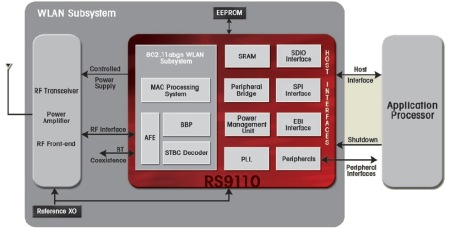WiFi chip squeezes 802.11n into MicroSD cards
Jan 9, 2008 — by LinuxDevices Staff — from the LinuxDevices Archive — 31 views Fabless chip vendor Redpine Signals says it is sampling an “ultra low power” 802.11a/b/g/n wireless networking processor suitable for use in MicroSD cards and mobile devices. The Linux-compatible LiteFi RS9110 utilizes advanced power management techniques spread over system, algorithm, and circuit levels, according to the company.
Fabless chip vendor Redpine Signals says it is sampling an “ultra low power” 802.11a/b/g/n wireless networking processor suitable for use in MicroSD cards and mobile devices. The Linux-compatible LiteFi RS9110 utilizes advanced power management techniques spread over system, algorithm, and circuit levels, according to the company.
Combining baseband and MAC (media access control) processing, the RS9110 targets a wide variety of devices, from phones to personal navigation devices (PNDs) to digital cameras. It comes in wafer layer chip scale packaging (WLCSP) and SiP (system in package) form factors, Redpine says, making it suitable for incorporation into, for example, MicroSD cards.
Features and benefits cited by Redpine for the RS9110 include:
- Single-antenna IEEE 802.11n with space time block code (STBC) support
- 1×1 802.11n mode conforming to WiFi Alliance's handheld (HH) certification profile
- Patented low-power techniques to minimize power consumption
- Full-throughput SDIO v1.2/2.0
- Serial peripheral interface (SPI) and expansion bus interface (EBI)
- Zero host overhead architecture with proprietary processor core
- WEP, TKIP, and AES hardware engines for line-speed security support
- Advanced 802.11e-based QoS support, including wireless multimedia extensions (WMM) and wireless multimedia power save (WMM-PS)
- Bluetooth coexistence support
- Backward compatibility with IEEE 802.11a/b/g
According to Redpine, the RS9100 uses substantially less power than competitive products that do not support 802.11n, though it did not quantify this.

A block diagram of Redpine's RS9110
(Click to enlarge)
Venkat Mattela, Redpine's CEO, said, “Our research spanning over six years concludes that the silicon geometry has minimal effect on power consumption, as compared to the effect on power due to wireless performance and system level optimization techniques. Lite-Fi unveils intrinsic advantages of 802.11n for low power over 802.11b/g, and we enhance it further with our unique and proprietary patented techniques to optimize the power for the total signal chain.”
Competing products
The company is, of course, far from alone in introducing Linux-compatible, power-sipping chips for the booming WiFi market. Last week, Ralink Technology introduced the RT3080, claimed to draw under 300mW in full-speed receiving mode. In October 2007, Atheros announced the AR6002, said to draw “near-zero” power when in standby, and 70 percent less power than previous WiFi technologies even when active.
ABI Research forecasts over 3.7 billion cumulative WiFi integrated circuit shipments from 2008 to 2012, according to Redpine's statement. Of these, approximately 75 percent are expected to be 802.11n (which includes the products mentioned above).
Philip Solis, senior analyst at ABI Research, said, “We expect the embedded WiFi market to reach over one billion cumulative shipments by the end of 2010. WiFi chipmakers will be required to deliver solutions that address new size, cost, and power paradigms.”
Availability
Redpine says the RS9110 is sampling now, with volume shipments expected during the first quarter of 2008. An SD card reference design is also available, claimed to be the industry's first SDIO card to be certified for 802.11n draft 2.0 by the Wi-Fi Alliance.
According to the company, software support for the RS9110 includes complete MAC firmware, reference drivers, manufacturing software, and a configuration graphical user interface (GUI) for Linux, Windows CE, Windows Mobile, and Windows XP.
This article was originally published on LinuxDevices.com and has been donated to the open source community by QuinStreet Inc. Please visit LinuxToday.com for up-to-date news and articles about Linux and open source.